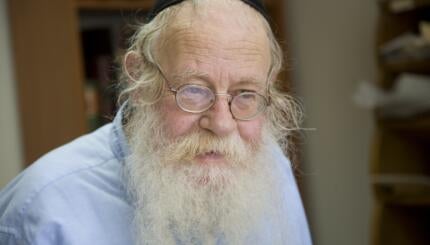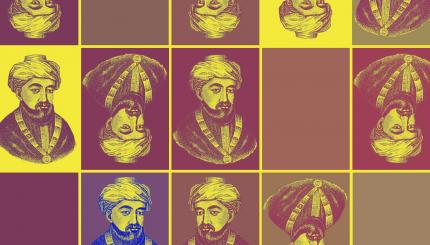Isaac Luria was a 16th-century rabbi whose teachings exerted an enormous influence on the development of Jewish mysticism. Often referred to as the Ari (an acronym for HaElohi Rabbi Yitzhak, or “the divine Rabbi Isaac”), or as the Ari Hakadosh (“the holy lion”), Luria lived only to age 38 and left behind no significant writings. But he is arguably the single most important figure in the history of Kabbalah, developing a profoundly detailed cosmological vision that imbued the Jewish commandments with deep mystical significance. Centuries after his death, Luria’s vision of Jewish religious practice as a means of elevating the divine sparks scattered throughout the material world continues to animate Jewish spiritual striving.
The record of Luria’s life is unusually scarce. For much of his career, he held no formal position. The critical period of his life was his final three years, during which he lived in Safed in northern Israel and led a small circle in mystical fellowship. Most of what is known of his teachings come from the writings of his followers, in particular Rabbi Haim Vital, the greatest single source of information about Lurianic traditions. In a similar manner to the Baal Shem Tov, who would popularize Lurianic teachings in Eastern Europe in the 18th century, much of what was written about Luria’s life is considered by scholars to be more mythic than factual.
Luria was born in Jerusalem in 1534. His father died when he was young and his mother took him to Egypt to live with her brother, whose daughter Luria would go on to marry. By the time he was in his early 20s, he was part of the inner circle of disciples of David ibn Zimra, the chief rabbi of Egypt and the author of several kabbalistic works. Documents in the Cairo genizah attest to the fact that Luria supported himself trading in leather, cucumbers, pepper and wine. Probably during the 1560s, Luria seems to have spent several years in solitude on an island in the Nile, returning home to his family only on Shabbat. Some scholars believe this is when he began to delve deeply into Jewish mysticism, studying the Zohar along with the writings of Moshe Cordovero. He also likely began composing kabbalistic works of his own during this time, and perhaps also engaged in contemplative practices.
It was almost certainly his attraction to Kabbalah that induced Luria around 1570 to move to Safed, a mountaintop village in the Galilee that, by the early 16th century, was the global center of Jewish mysticism and home to a vibrant community of mystic rabbis, including Cordovero, Joseph Karo and Shlomo Alkabetz, composer of the Friday night hymn Lecha Dodi. Safed is also near to the burial place of Rabbi Shimon bar Yohai, the supposed author of the Zohar with whom Luria had a deep identification. Within months of Luria’s arrival in Safed, Cordovero died, leaving a gap as the head of the kabbalistic community that Luria quickly filled.
With your help, My Jewish Learning can provide endless opportunities for learning, connection and discovery.
Among his followers, Luria had a reputation not only for personal piety, but for possessing supernatural abilities that granted him access to secret knowledge. He was said to be capable of summoning any soul he desired to answer his questions; Elijah the prophet was a frequent interlocutor. He could understand the language of animals and even inanimate objects like rocks and trees, which Luria believed possessed souls. He could discern the inner workings of a person’s soul as well as their past lives by feeling their pulse or reading Hebrew letters he could see inscribed on their forehead. And he was an expert dream interpreter and healer who could concoct plant remedies. “Up until Isaac Luria, there had been no significant public figure in the entire history of postbiblical Judaism — with the obvious exception of the figure of Jesus — concerning whom a comparable cluster of such remarkable claims were made,” Lawrence Fine wrote in his study of Luria, Physician Of the Soul, Healer Of the Cosmos.
Among the most influential parts of Lurianic thought is his account of the origins of the cosmos. Though drawn from earlier rabbinic and kabbalistic ideas, Luria wove a precisely detailed narrative of creation whose first act was tzimtzum, or divine contraction. Originally a talmudic concept, in Luria’s reinterpretation tzimtzum was required because God’s presence was so all-pervasive in the primordial cosmos that creation could only emerge if God withdrew (or concentrated) to make space for the physical universe.
Another central kabbalistic concept that comes from Luria is the doctrine of shevirat hakeilim, the “breaking of the vessels,” in which God’s light was so powerful that the vessels meant to contain and channel it into the physical world couldn’t withstand it and shattered, scattering particles of divine light throughout creation. Reunifying these shards with their divine source and restoring primordial harmony, a process known as tikkun, is the principal objective of human spiritual practice — and the deeper purpose behind performing mitzvot. “According to Luria the meaning of the acts which the Torah prescribes or forbids is none other than the execution, by and in the individual, of this process of restitution of man’s spiritual nature,” the Kabbalah scholar Gershom Scholem has written.
Luria died in a plague in 1572. According to Vital, “his soul left him by a kiss,” an echo most likely of the talmudic teaching that Moses died “by the mouth of God” (Bava Batra 17a). He was buried in Safed and his grave remains a site of pilgrimage to this day.



